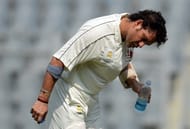An era indicates a longer span of time. It denotes a major period of the history. Sometimes, it is used to describe a special character, the period of his domination and the mark he has left on people’s hearts and in their minds. Sachin’s international career lasted for a long time, 24 years to be precise. It wasn’t just a career, it was an era, the Sachin Era. We all grew up in this Sachin Era.
Our lives changed a lot from being a child to a teenager to a matured person. From school-going kids to college boys to office guys. But one thing remained constant – Sachin Tendulkar. He was always there. Playing in whites, playing in blues. He was a part of our daily life and an inspiration for many. If cricket was a religion, he was a God. Many of us worshipped him and wished for his and team’s success.
My first memory of Sachin is the Hero Cup. It’s a distant memory, a fading one. I just remember some glimpses of it. Then there were some advertisements of him on TV, and then there were some playing cards with his photos on them.
I didn’t follow cricket religiously then, I didn’t know any rules. I wasn’t a cricket fan yet. I think it was 1996′s Titan Cup when I started to follow cricket religiously and if I am not wrong it was Sachin’s first series as Indian captain. I remember him lifting the trophy after that low-scoring final match against South Africa.
Sachin has seen Indian cricket to go from the dark age to its golden age. India was an average cricket team in the 90s, they used to lose more often than win. Snatching defeat from the jaws of victory was their favourite hobby. Sachin was the only shining star, the only hope. No match was over till he was there. India usually thrived on his individual brilliance.
People used to turn their TV sets off when Sachin got out. That’s how mediocre that Indian team was, and that’s how amazing Sachin was. He was the reason for that smile on millions of faces. He was the heartbeat of India.
In the second half of his career, he got surrounded by a better set of players. A bold leader Sourav Ganguly emerged, some dynamic young guys entered the scene. It was a fearless Indian team, and it was just the beginning of the golden age of Indian cricket.
Sachin’s workload decreased a bit, but the years of hardwork and non-stop cricket had started to take its toll on his body and the injuries started to hit him. Tennis elbow being the deadliest, and it threatened to end his career. He couldn’t lift his cricket bat for months. But he braved the storm, he fought and returned. It gives us a glimpse of the fighter inside him. These injuries forced him to change his batting style a bit, but the will was still the same, will to score runs, more runs.
He was admired by all, even by his competitors and opponents. He never took his success to mind. Humbleness was one of his prime virtues and he maintained it throughout his glorious career. When a batting legend Brian Lara compares Sachin’s impact on cricket with Michael Jordan‘s in Basketball and Mohammad Ali’s in Boxing or when a majestic leg-spinner Shane Warne accepts that he was the greatest batsman of his era, you know he must have been a special player.
“What came out was that he was a genius who thought deeply about his craft. His mind was like an advanced computer which absorbed information, processed it, saved what was important.” This is how cricket columnist Amrit Mathur explained the genius of Sachin. In his latest piece, Rohit Brijnath gives some more insights on him and his way of thinking. When Sachin explains how he sometimes compels bowlers to do what he wants, you know he isn’t joking. That’s a master at work for you. He has done this on numberous occasions. There are many stories about Sachin and almost every cricket writer and his fellow cricketers have something to tell.
There are many memories of Sachin’s glorious knocks. People talk about his Perth knock, his Old Trafford hundred. I didn’t see those but I have seen most of his finest. His twin hundreds in Sharjah stands out. His aggression against Shane Warne during that Chennai masterclass, his onslaught against Shoaib Akhtar in that 2003 World Cup match, that Six over the point was sheer brilliance. His Chennai knock after Mumbai blasts, his handling of one of the best ever fast bowling spells by Dale Steyn. His 175 in Hyderabad and his ODI double hundred. That Chennai 136 against Pakistan came in a losing cause but that was undoubtedly one of his finest.
That World Cup winning night at Wankhede Stadium was the peak of Indian cricket’s golden age. India were Test No.1 then and even Sachin’s personal form was alright. I think even Sachin will consider it as the highest point of his career.
I find myself blessed to have seen it all and each one of these will remain etched in our memories forever.
People always talk about Sir Donald Bradman, they talk about Vivian Richards but I have never seen them bat, I only saw Sachin. For me, he is and will remain the greatest batsman ever. Cricket will always be there but it will be little less magical without the Master. Thank you Sachin!
Follow IPL Auction 2025 Live Updates, News & Biddings at Sportskeeda. Get the fastest updates on Mega-Auction and cricket news


